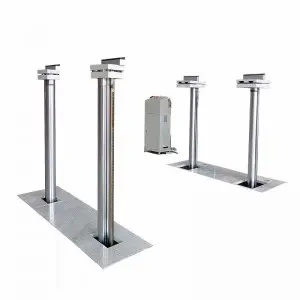Inground lifts are an essential piece of equipment in automotive repair shops and service centers. These lifts provide mechanics and technicians with a safe and efficient way to elevate vehicles, enabling them to access hard-to-reach areas and perform various maintenance and repair tasks. In this comprehensive guide, we will explore the advantages and different types of inground lifts available on the market today.
One of the key advantages of inground lifts is their space-saving design. Unlike above-ground lifts, inground lifts are installed directly into the ground, which maximizes the usable floor space in the workshop. This can be particularly beneficial for smaller-sized garages or service centers with limited space, allowing them to make the most of their available area.

The Advantages and Types of Inground Lifts: A Comprehensive Guide
Inground lifts come in various configurations to accommodate different vehicle types and sizes. Two-post inground lifts are commonly used for passenger cars and light trucks, while four-post inground lifts are ideal for heavier vehicles such as trucks and SUVs. These lifts are designed to support the weight of the vehicle evenly, ensuring stability and safety during the lifting process.
Safety is a paramount concern when using any type of vehicle lift, and inground lifts are equipped with extensive safety features. Some of these features include automatic safety locks that engage when the lift reaches the desired height, preventing the vehicle from descending unexpectedly. Additionally, many inground lifts have hydraulic synchronization systems that ensure the lifting arms move in perfect unison, preventing any tilting or imbalance.

The Advantages and Types of Inground Lifts: A Comprehensive Guide
Maintenance is another crucial factor to consider when choosing an inground lift. Regular maintenance and inspections play a vital role in ensuring the longevity and reliable performance of the lift. It is essential to follow the manufacturer’s guidelines, including lubrication of moving parts, and checking cables and hydraulic systems for any signs of wear or damage.
When selecting an inground lift, it is crucial to assess the weight capacity required for your specific needs. Inground lifts can have weight capacities ranging from several thousand pounds to over 100,000 pounds. It is vital to choose a lift that can accommodate the maximum weight of the vehicles that will be serviced in your shop or service center.

The Advantages and Types of Inground Lifts: A Comprehensive Guide
Installation of an inground lift should only be carried out by experienced professionals as it involves cutting a hole into the shop floor. This process requires precise measurements and the proper installation of hydraulic lines, cables, and other components. Hiring a qualified installer guarantees that the lift is correctly installed and compliant with all safety regulations.
Inground lifts are an investment that can significantly improve the efficiency and productivity of an automotive repair shop or service center. With their space-saving design, safety features, and various configurations, inground lifts offer mechanics and technicians a reliable tool to elevate vehicles and perform repairs more efficiently.
In conclusion, inground lifts provide numerous benefits for automotive repair facilities, including space optimization, safety features, and versatility. Selecting the right inground lift for your specific needs requires careful consideration of weight capacity and adherence to maintenance protocols. By investing in a high-quality inground lift and ensuring proper installation, you will enhance productivity and safety in your shop, leading to improved customer satisfaction and profitability.New Engery Vehicle Battery Lift
